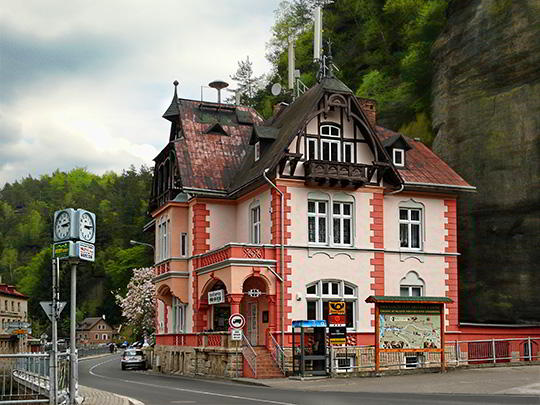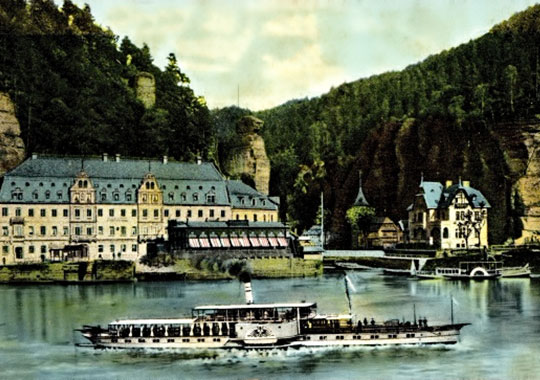About Hřensko
Today
The border municipality Hřensko represents an entrance gate into the Bohemian Switzeland National Park. The access road from Děčín to Hřensko itself is fascinating for its beautiful scenerio of the great sandstone mountain canyon and the Elbe River. The surrounding mountains rise from the canyon hundreds of meters above the river and guard the surroundings.
Its position at the junction of rivers Labe and Kamenice, 115 metres above sea level makes Hřensko the lowest situated place in the Czech Republic. Despite its low altitude, the surrounding scenery creates an extraordinary sight which will make you feel as if you were in the mountains. Nature, in which Hřensko is embedded, is wonderful.
Visitors will definitely be amazed by the massive canyon of the Elbe River and the beautiful valley twining along the river Kamenice. A large part of the municipality is situated in this valley, which is surrounded by rocks from both sides. Low temperatures between the rocks make it possible for mountain plants to grow here, which at altitude this low is a great curiosity.
Hřensko is a starting point for trips to Pravčická brána, the largest natural stone bridge on our continent, and to the gorges of the Kamenice River, where it is possible to take a boat ride with ferryman’s commentary.
History of the Municipation
The history of the area, where Hřensko is situated, goes back to the beginning of the 15th century. In documents of Berks of Vysoká Lípa from the year 1408 there is a reference about a deviation form the Česká Road to a tavern located on the shore of the Elbe River. The tavern used to serve sailors and raftsmen (after several reconstructions Panský dům – Herrnshaus).
Next written reference about Hřensko from the year 1475 refers to an assault on three Norimberk merchants. The place had been well known, the already mentioned deviation from the Česká Road led here, to the Elbe River. Near the delta of the Kamenice River there was a wood storage, also a mill was in service. Timber rafting required lumber-jacks and sailors to build their own shacks here.
In the years 1530 – 1550 new settlers began to arive. No longer only wood was floated on the Elbe River, but also grain, glass and salt was stored in Hřensko storages. At that time Salhausens were the owners. After their bankruptcy in 1612, creditor Johann of Wartemberg became the owner of Hřensko, followed by the families Wchinitz and Aldrings, and since the year 1664 the Clary-Aldringens.
After the death of general John of Aldringen in the Thirty Years’ War, the possessions were divided between the heirs. And so it happened that inhabitants of Hřensko and Mezná were governed by four authorities. Only during the reign of Francis Karl in the year 1709 were all parts merged together, thus forming the Binnsdorf masterdom.
In the 17th century the importance of Hřensko as a trading centre had risen. Timber working remained the vital industry. In the 18th century there stood four saw mills in Hřensko, one of them had been then transformed into a hospital during a cholera epidemic. Several raft tying workshops were in service, timber was floated to more distant places. Great speciality were huge, hundreds of years old trunks, which were delivered to naval shipyards and used for manufacturing the masts of sailboats. Timber was also used for homemade shingles, dishes, tools, hop poles and other goods. In charcoal pits in the woods, charcoal and grease was made. Also mushrooms were traded.
Because of grain trade, mills have been developing. In Hřensko there were three of them, the younger one had been converted to the U mlýna Hotel (Zu Mühle) after a fire. Today the Klepáč Hotel.
Mining and processing of sandstone was another important industry. It was being exported far to Dresden.
For local people clandestine trade was also a source of income (the Podloudnice Trail is known already in the year 1492). Salt, tabacco, cloth and other goods were smuggled here. However, after the Thirty Years’ War the border was better guarded. In the year 1656 there is documented a station that was in charge of control of the salt trade, and in the 30’s of the 18th century a tollbooth.
The introduction of steam navigation had a big significance, the very first steamboat sailed through Hřensko on the 15th of June 1838. General develpment of the 19th century had no significant influence on Hřensko. The only industrial company was a chemical plant producing sheep wool and silk dyes. Soon the property had been converted into a branch of a Dresden company producing threads used in sewing machines (in service until the year 1945).
In the 19th century tourism in Hřensko begins to evolve, supported by the masterdom’s owner duke Edmund Clary-Aldringen. In the 30’s of the 19th century, the path to Pravčická brána was built, also hotels, pensions and taverns were being built. In the year 1862, Gustav Kreibich founded a local company, which among other things sold photographs and picture postcards of Hřensko.
In the year 1890, the gorges are finished and opened. In the year 1879, sections of the Czech Switzerland Mountain Club are forming in Hřensko and Vysoká Lípa. Its members built trails, roads, observation points, handrails, benches, bridges, they also published promotional and educational prints, and organized various meetings.


